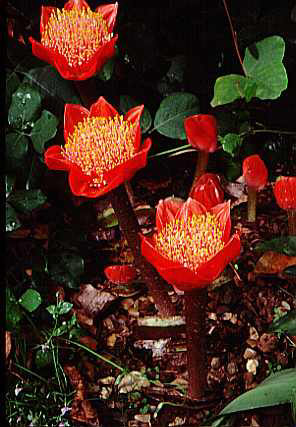Haemanthus coccineus
Cape tulip
A perennial bulb to 35cm, with stout brownish stems each bearing an umbel of small red flowers, surrounded by showy scarlet bracts; fruits fleshy, white to red. Strap-shaped leaves appear after the flowers
Other common names
African tulipApril fool
see moreblood flower
blood lily
red Cape flower
red Cape tulip
Size
Ultimate height
0.1–0.5 metresTime to ultimate height
2–5 yearsUltimate spread
0.1–0.5 metresGrowing conditions
Moisture
Well–drainedpH
Alkaline, NeutralColour & scent
| Stem | Flower | Foliage | Fruit | |
| Spring | Green | |||
|---|---|---|---|---|
| Summer | Red | Green | ||
| Autumn | Red | Green | Red White | |
| Winter |
Position
- Full sun
- Partial shade
Aspect
South–facing
Exposure
Sheltered Hardiness
H2Botanical details
- Family
- Amaryllidaceae
- Native to GB / Ireland
- No
- Foliage
- Deciduous
- Habit
- Tufted
- Potentially harmful
- Ornamental bulbs - not to be eaten. Wear gloves and other protective equipment when handling Pets: Ornamental bulbs - not to be eaten - see the HTA guide to potentially harmful plants for further information and useful contact numbers
- Genus
Haemanthus are evergreen or deciduous perennial bulbs with strap-shaped or broadly elliptic leaves and small flowers in dense umbels, sometimes with colourful bracts, and followed by fleshy, white or red fruits
- Name status
Correct
- Plant range
- S Africa
How to grow
Cultivation
Plant bulbs with the necks just above the surface, when dormant, in moderately fertile soil. Under glass grow in peat-free, loam-based potting compost with added leaf mould and grit in full light. Flowering will be prolonged if light levels are reduced when the buds open. Water freely when in growth and apply a dilute balanced liquid fertiliser monthly. Keep just moist when dormant and do not pot on regularly as flowering is best when congested
Propagation
Propagate by seed or remove offsets in early spring
Suggested planting locations and garden types
- Flower borders and beds
- Underplanting of roses and shrubs
Pruning
No pruning required
Pests
Generally pest-free
Diseases
Generally disease-free
Get involved
The Royal Horticultural Society is the UK’s leading gardening charity. We aim to enrich everyone’s life through plants, and make the UK a greener and more beautiful place.
